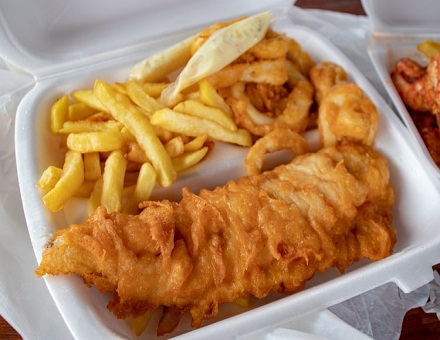Traditional British fish and chips – a short history

The easing of lockdown restrictions means that I can now enjoy traditional British fish and chips at my favourite fish restaurant.
Fish and chips is an iconic British food that has been an established favourite for over 150 years.
While the french fry originated in France or Belgium, in northern England the thick cut variety established itself in the seventeenth century. At around the same time, jewish refugees started selling fish coated in flour in London. This was usually served with bread rather than chips, and was often referred to as the “jewish method” of preparing fish.
In the early 1860’s the first fish and chip shop opened in London or Oldham. The idea spread rapidly, fish and chips being affordable and nutritious.
In 1896 the first fish restaurant opened. It offered restaurant dining at a price that was affordable to many who would rarely be able to dine out.
Many of the early fish and chip shops were run from the front rooms of private homes.
By the 1930’s there were 35,000 fish and chip shops in Britain.
Consumption of fish and chips on a large scale was possible because of the growth of the British North Sea fishing industry. British fishing boats had fished off Iceland since the fourteenth century and off Newfoundland (Canada) since the seventeenth. The invention of steam trawlers in the 1870’s, together with a developing rail network that allowed the fish to be transported from the ports to the cities helped develop fish and chips as a major food source for the nation.
In 1925 Clarence Birdseye invented a system for freezing the fish while at sea.
Overfishing first became a problem in the 1920’s and when prices fell during the depression of the 1930’s fishermen tried to maintain incomes by catching even more fish. Fish stocks in the North Sea recovered when fishing paused during World War II.
Factory trawlers were introduced in the 1950’s, by which time Grimsby was the largest fishing port in the World.
There were continuing fears of overfishing and disputes, especially with Iceland which ultimately declared a 200m territorial limit aimed at protecting fish numbers and their own fishing industry. It is now believed that North Sea fish stocks are at sustainable levels, but negotiations between rival fishing industries continue.
Traditional British fish and chips
Cod and haddock are used in traditional fish and chips, sometimes cheaper white fish. Notices in the shop will usually tell you if you are buying cod or haddock.There are also numbers of fish and chip shops in Canada, the USA, Australia and New Zealand. The type of fish may vary according to what is available locally.
The batter is of flour and water (sometimes beer) with a little baking powder and vinegar. This used to be deep fried in lard, though now vegetable oil is more common.
Accompaniments vary around the UK. Mushy peas are often served with fish and chips, as are garden peas, chip shop curry sauce or gravy.
For our readers outside the UK
We know that we have visitors from outside the UK, so thanks for reading and please continue to do so!
Fish and chip “shops” are actually hot food takeaways. They are also referred to as “chip shops” or “chippies”. Some have a restaurant area attached.
Mushy peas have been soaked overnight with baking soda, then drained and boiled until soft or “mushy”. They are also often sold on their own, especially in the East Midlands and North, usually with mint sauce. Chip shop curry sauce is milder and sweeter than curry that you may find in an Indian restaurant, and is similar around the country.
Don’t visit the UK without trying traditional British fish and chips!
.
Don’t forget: Fathers Day is Sunday 20th June
.

